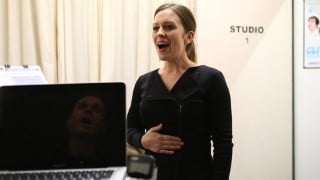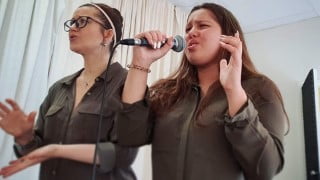Sing on pitch #2: Ultimate Guide to Sing Harmony by Ear
Learn how to understand harmony, pick out choir parts, and sing the right harmonies by ear. Find your voice type and arrange voice parts for your choir. Add beauty to your music and choir performance using harmony. Perfect for recording artists, choir members, singers, and studio engineers.
What you’ll learn
- You will be able to understand how harmony works
- You will be able to Pick out choir parts from a recording
- You will be able to hear, create and sing the right harmonies to most song by ear
- Find your voice type if you are a soprano, alto, tenor or bass
- You will be to arrange voice parts for your choir
- You will be able to add beauty to your music and choir performance using harmony
When a harmony is done well, two or more vocal parts come together in an arrangement that adds feeling, depth, texture, and perhaps even a sense of tranquility to a song.
Vocal harmonies involves singers singing different notes that are pleasing to the ear. i.e Soprano and alto singing their various parts
what makes a combination of notes “pleasing”?
I guess it depends on both the intentions of the composer, and the expectations of the listener. So, while a composer writing a “feel good pop song” would never consider smashing their flat hand across the low end of a piano to create a “pleasing effect,” another composer, writing the score for a horror film, might do this very thing to scare the heck out of its audience. To that composer, that is a perfectly “pleasing effect” in that it achieves the intended emotional impact.
This isn’t just random magic: chords are at play. Harmonization happens when musical notes combine into one chord often in thirds or sixths, and then into chord progressions. In a simple two-part harmony, the first person sings the melody and the second sings above or below that melody within the chord structure. In rock or pop music, a backup singer will harmonize with the lead singer by adjusting the pitch of her note based on the lead singer’s pitch so that they are in tune. In doo wop, backup singers would harmonize with each other in the background, taking the place of the instrument.
Some singers, like those involved with barbershop quartets, think of harmony as practically mathematical in nature. When they sing their four-part harmonies, getting it right is a science in which each singer has his or her own role often based on their voice type. For others, the ability to harmonize well is a skill they can’t explain but they’ve developed by listening and practicing, with that perfect harmony buzz as the goal. Many persons who find harmonies hard to explain but easy to sing have grown up in a church setting, hearing and singing hymns when they were very young.
If you find it difficult to find and stick to your voice parts, this course is for you because i started learning harmony at a much later time
Learn how to:
pick out choir parts from a recording
Train you ear to hear/find the right harmonies to any song by ear
find your voice type if you are a soprano, alto, tenor or bass voice
and others
Who this course is for:
- Recording Artist
- Choir members and Directors
- Singers
- Studio Engineers
User Reviews
Be the first to review “Sing on pitch #2: Ultimate Guide to Sing Harmony by Ear”
You must be logged in to post a review.







There are no reviews yet.